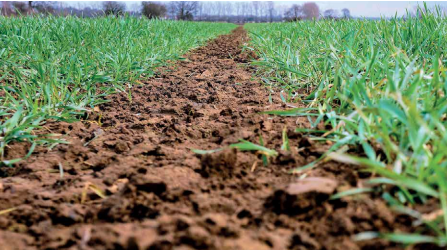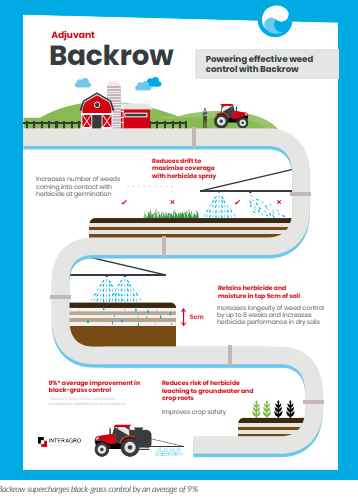How can you keep weeds and disease at bay this spring? As warmer weather arrives and the season gets underway, we explore here the role of adjuvants in boosting the performance of herbicides and fungicides on farm to optimise weed and disease control.
Right time, right place
Bumper harvests are made in spring. Where every kilo counts, optimising a fit and healthy crop free from weed and disease competition is absolutely essential. Of course, this is easier said than done. As certain species become resistant to herbicides and fungicides, restrictions tighten and active ingredients disappear from the crop protection toolbox, the job certainly isn’t getting any easier for farmers. If conditions are challenging during application, as they so often are these days, things become even more stressful. Plants struggle, workloads rise and yields fall.

There isn’t much we can do about the weather. What we can do is make sure that crop protection products are delivered to the right place, at the right time – and that the tools we have are working as hard as possible. This is where adjuvants are worth their weight in gold. E m p l o y i n g a suitable a d j u v a n t e n s u r e s herbicides and fungicides are delivered exactly where needed, m a x i m i s i n g effectiveness and protecting yield. For those looking to get the most out of rotational weed control this spring, they are practically a secret weapon.
Kick-start your weed control programmes
We know that spring crops are limited in their post-emergence armoury. To give your plants the best start in life, it’s a matter of control. While the majority of black-grass germinates in autumn, the startling truth is it only takes 12 plants/ m² to reduce yield by as much as 5% and power seed return of an eye-watering 144m seeds per hectare. Pre-emergence residual herbicides need to be applied with precision in problem fields to protect yield, keep on top of populations and prevent issues in the next crop. Working in lighter soils, getting rid of spring germinators early – like knotgrass, black bindweed and redshank – defends sugar beet, potatoes and the like – crops where early establishment, free from weed competition is vital to protect yield. During the pre/peri-emergence spray timing your aim is to get maximum coverage with the spray and retain the herbicide in the top 5cm of the soil to control new flushes of germinating weeds that may appear over time.

This can be challenging for three reasons:
1. Coverage can be compromised by drift, reducing the applied dose, missing parts of the soil altogether and allowing weeds to germinate and outstay their welcome.
2. The dry soils typically seen in spring have an impact on performance.
3. Levels of moisture in the soil can affect retention and therefore leach the potential of the herbicide.
Designed to reduce drift, a low-drift nozzle produces bigger droplets but reduces coverage –meaning we still have problems two and three to deal with. This is where a residual herbicide adjuvant like our Backrow product can help. Adding Backrow to spray water both reduces drift and improves coverage. The product helps soil retain herbicide and moisture in the top 5cm of soil for up to eight weeks and prevents herbicides leaching to groundwater or the roots of the crop itself. Used in this way, Backrow improves the efficacy and longevity of weed control and general crop safety, particularly in light soils. Field-scale research on onions has shown that where Backrow was applied pre-emergence, the leaching of all subsequent crop protection products was dramatically reduced. Follow-up work using lysimeters in a controlled environment revealed that the product upped water retention by 33% and diminished leaching by an incredible 62%.
Four ways Backrow can help increase overall weed control
Adding Backrow to your weed control has four central benefits:
• Increases contact between the herbicide and the weed
• Increases effectiveness of herbicide in dry conditions
•Increases longevity of weed control
• Improves crop safety
Over the past nine years, replicated trials have been carried out with a range of herbicides applied both pre and periemergence. The results of these trials have shown conclusively that Backrow advances the performance of herbicides by an average of 9%. Let’s crunch the numbers; for a black-grass population of 500 heads per m², 9% means a yield benefit of 0.45 t/ha, or to put it in financial terms, a margin of roughly £80/ ha. Importantly, it also means a reduction in black-grass seed return to the tune of 270,000 seeds per hectare (based on seed viability of 60%), protecting future crops from competition.
Broadleaf weed control in cereals: +13%
Broadleaf weed control in combining peas: +13%
Broadleaf weed control in spring beans: +10%
Broadleaf and grass-weed control in potatoes: +8%
Enhancing weed control post-emergence
Once weeds have surfaced, we are dealing with an entirely new target; aiming to get herbicide into a small established weed, rather than sufficient coverage of the bare soil. If the weed gets particularly big, hairy, or waxy in texture, things become even more tricky. What then if applications are delayed due to weather or workload? … If you find yourself with an out-ofcontrol weed situation, choose your solution wisely. A good adjuvant should reduce drift and improve retention on the leaf, rather than allowing the herbicide to simply bounce or run off the surface.
It will aid spreading across the leaf to optimise entry points, improve penetration and increase uptake. Sulfonylurea (SU) herbicides in particular benefit greatly from the addition of an adjuvant; on a molecular level, the very small nature of the active ingredient makes it hard to wet in formulations. Adjuvants like Arma and Kantor are ideal in this situation. Kantor would be the better choice to reduce drift and/or when using hefty tank mixtures. It has the ability to keep complex mixtures stable within the solution; a notable benefit with Basagran in spring beans which can be “hot” on the crop.
Pushing the performance of fungicides
While SDHI/azole mixtures have proven effective in controlling Septoria in cereals, monitoring data shows there has been another slide in sensitivity to SDHIs and azole chemistry. At present, we’re also experiencing disease control challenges in controlling Cercospera in sugar beet and Ramularia in barley, to name a few vicious examples. We’re not saying that adjuvants are the holy grail, but there’s no denying resistance poses a significant threat to the ongoing performance of fungicides. By optimising the application process, we can not only increase efficacy and yield, but importantly also reduce negative genetic effects and slow resistance.
During fungicide application the aim is to get as much of the active ingredient inside leaves as is possible. The surface area to hit is large and we need to protect it all. While multi-sites act as a protectant, they don’t move on the leaf. This means they can only protect the portion of the leaf they actually cover. If the base of the leaf doesn’t receive adequate coverage, the fungicide will be prevented from moving downwards, leaving that part of the leaf either completely unprotected or having received a sub-lethal dose of the active ingredient.
Although they work slightly differently, both the Arma and Kantor products will improve spreading and uptake to protect the whole crop. Prothioconazole-based mixtures will benefit in particular as it is a large molecule which needs to be converted to desthiocolnazole inside the leaf for it to be “activated” – so the quicker it gets inside, the faster it starts working. Extensive trials over the past seven years have also shown that where Kantor is added to prothioconazolebased sprays with chlorothalonil, antagnosism is reduced and yield is improved.
Over 6 years of trials, 44 comparisons, average yield benefit in winter wheat across all timings: +0.28 t/ha
+14% improvement in Cercospera control in sugar beet with epoxiconazole + thiphanate-methyl
Up to 18% improvement in Downey mildew control in onions with Invader
Our top tips
So how to get the best out of your herbicides and fungicides this spring?
• Choose your crop protection carefully and make sure it is applied in the right place, at the right time.
• Incorporate a suitable adjuvant to ensure your herbicides and fungicides are working as hard as possible.
• Aim for the highest levels of control when applying pre-emergence residual herbicides to give crops the best possible start in life.
• A good offence is the best defence. Use pre-emergence herbicides in problem fields in the spring to keep on top of weeds and safeguard against issues in the next crop.
• Rid lighter soils of spring germinators like knotgrass, black bindweed and redshank as early as possible. In crops like sugar beet and potatoes, doing so is crucial to protect yield.
• Employ crop rotation where necessary to crowd out weeds via competition.
• Pre/peri-emergence, choose a low-drift nozzle and aim for max coverage. Adding a residual herbicide adjuvant like Backrow can help optimise soil coverage and retain herbicide and moisture in the top 5cm of soil for up to 8 weeks.
• Post-emergence, aim to get as much of the active ingredient in the weed leaf as possible. Adjuvants Arma and Kantor improve coverage and uptake to control as many weeds as possible.
• To boost the performance of fungicides, apply an adjuvant like Arma or Kantor to boost spray coverage and uptake to protect the whole crop.
Adjuvants like Backrow, Arma and Kantor are a valuable tool, pushing performance of herbicides and fungicides and helping you get the most from your crop in health and yield. To discuss individual scenarios or to request product guides, please feel free to get in contact with us at info@interagro.co.uk.

